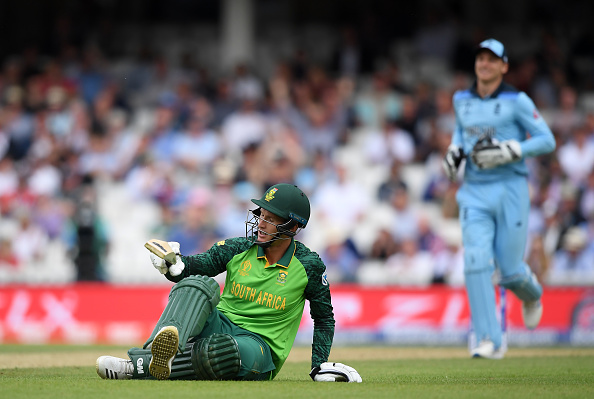Brutal. Clinical. Bullied. Men against boys. Choose whatever reference you want but England showed why they are World Cup favourites when swatting aside South Africa in the opener at The Oval, writes GARY LEMKE.
Player ratings: Harsh but fair assessment of Faf’s bunch
In winning by 104 runs and bowling out the Proteas for 207 in under 40 overs (39.5) after having been sent into bat after losing the toss, Eion Morgan’s team proved that they’re much more than a batting unit that is determined to be the first team in history to score 500 in a 50-over ODI match.
5 takeaways: Proteas come up short
They ‘only’ managed 311 from their 50 overs, and that being after losing their first wicket (Jonny Bairstow) to the second ball of the tournament, following an inspired decision by Proteas skipper Faf du Plessis to hand the hard new white nut to wrist-spinner, 40-year-old Imran Tahir.
It was a throwback to 1992 when New Zealand, co-hosts of a World Cup whose format applies for the first time since at this 2019 version, opened the bowling with spinner Dipak Patel. Then, it caught teams by surprise and at The Oval, it had the same effect. Tahir got Bairstow with a first-baller and it was game on.
But, having won the toss and created the element of surprise South Africa’s bowlers got it wrong. Coming into the World Cup we have heard and read that the Proteas have the best bowling attack in the tournament, so it was always going to be a case of their bowlers against the opposition batsmen. Given that former West Indian speedster is the coach, that was understandable and understood by all.
Yet, England went from 1-1 after the second ball to 60-1 after 10 overs. Lungi Ngidi leaked 27 runs in his unconvincing first four overs and looked down on pace, some 10km/h slower than Kagiso Rabada. Ngidi operated in the 135km/h zone and it was only after he came back for his third spell (having conceded 45 runs from his first six overs) that he proved to be troublesome, the slower delivery being his trump card and ending with 3-66 from 10 overs. His opening spells are worth questioning: Why was his initial pace down, opening the bowling in a World Cup tournament and not getting above 135km/h?
Even though the pitch looked spongy and gave tennis ball bounce, the feared Proteas bowling attack didn’t react quickly enough. They didn’t bowl full enough early on and when they analyse those first 10 overs they will see that their length was the shortest they have bowled for the last 20 ODIs that South Africa have played. And, with an England side comfortable at going at a run a ball, hindsight shows they missed a trick.
It seemed as if they gambled on bowling short, hitting the bat high, but banked on a ‘traditional’ Oval pitch and didn’t adjust.
When England bowled, Jofra Archer showed what an effective bouncer was.
Still, England kept going, nothing special mind you.
They went through 10 overs at 60-1, 20 overs at 112-3, 30 overs at 170-3, 40 overs at 235-4 and ended with 311-8. That means 10-over bunches of 60, 52, 58, 65 and 75. The latter 10 overs is interesting because England, in recent times, average around 90 for their last 10 overs at the crease, while South Africa average just above 60 in conceding runs. The Proteas were surely hopeful at the change of innings? Certainly 312 seemed a do-able chase – and the bookies agreed, making it a 56-44 percent call in favour of England.
However, Quinton de Kock apart, it quickly became apparent that this South African team are more pretenders than contenders for the trophy. Their strength lies in their bowling, but it was disappointing to see the lack of energy in the field and if one goes into an event saying they’ve selected a player (Dale Steyn) who is ’60 percent fit’, and that player is one of your trumpcards, that too smacks of an emotional decision.
Being bowled out for 207 with 61 balls left on a pitch where England scored 311 is wholly disappointing. In the field, too many ones became twos. Where can one hide Hashim Amla, Tahir and Dwaine Pretorius at this level?
Obviously, there were notable exceptions – the catches of Aiden Markram and Du Plessis, plus the glovework of De Kock were world-class. Du Plessis was outstanding juggling his bowling unit and leading by example in the field, but it’s hard to see him doing so for another 10 matches if he is going to win the tournament.
At a World Cup, world-class is par. England were par for 50 overs but then they changed gear. Just look at Ben Stokes’ catch of Andile Phehlukwayo and his batting (top score of 89 off 79 balls) and then 2-12 in 17 balls.
South Africa’s saving grace is that the analysts reckon five wins in nine matches will be enough to reach the semi-finals, given the tournament’s format. They should be able to achieve that, but history also shows that any team to have lost the opening match of a Cricket or Rugby World Cup has never gone on to lift the trophy.







